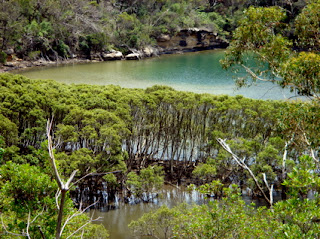 David introduced me to one of his favourite bushwalks that is conveniently located very close to home on Middle Harbour, ranging from the hilltop with Eucalypts, numerous wildflowers and lizards to the shoreline, rimmed with oysters, perch swimming in the shallow waters, mangroves, stingrays, sandstone ledges overhanging the gentle lapping of waves and the rushing sound of wind through the casurina trees. It is a little 5km loop. By midday the cacophony of cicadas was ubiquitous but I intend to return to practice in the early morning.
David introduced me to one of his favourite bushwalks that is conveniently located very close to home on Middle Harbour, ranging from the hilltop with Eucalypts, numerous wildflowers and lizards to the shoreline, rimmed with oysters, perch swimming in the shallow waters, mangroves, stingrays, sandstone ledges overhanging the gentle lapping of waves and the rushing sound of wind through the casurina trees. It is a little 5km loop. By midday the cacophony of cicadas was ubiquitous but I intend to return to practice in the early morning.
Thursday 14 December 2006
Discovered new shak prac spot ...
 David introduced me to one of his favourite bushwalks that is conveniently located very close to home on Middle Harbour, ranging from the hilltop with Eucalypts, numerous wildflowers and lizards to the shoreline, rimmed with oysters, perch swimming in the shallow waters, mangroves, stingrays, sandstone ledges overhanging the gentle lapping of waves and the rushing sound of wind through the casurina trees. It is a little 5km loop. By midday the cacophony of cicadas was ubiquitous but I intend to return to practice in the early morning.
David introduced me to one of his favourite bushwalks that is conveniently located very close to home on Middle Harbour, ranging from the hilltop with Eucalypts, numerous wildflowers and lizards to the shoreline, rimmed with oysters, perch swimming in the shallow waters, mangroves, stingrays, sandstone ledges overhanging the gentle lapping of waves and the rushing sound of wind through the casurina trees. It is a little 5km loop. By midday the cacophony of cicadas was ubiquitous but I intend to return to practice in the early morning.
Wednesday 13 December 2006
Asialink Performing Arts Residency
[It doesn't rain ... it pours]. I received news that my Asialink Performing Arts Residency application was successful, to spend 3 months in Asia. I applied to do composition and interaction design at the Future University in Hakadote, Sapporo Island of Japan. [It looks like there may be some change to the host institution arrangement so I may take it up in Tokyo and Chichibu, with the possibility of including an additional Asian country]. I hope to catch the Chichibu Yomatsuri (Night Festival: floats, fireworks, Kabuki performances, a portable shrine, flutes and taiko drums). The objectives of this residency are to combine 3 activities: composing a new acoustic major work for shakuhachi and ensemble; studying shakuhachi playing with Kakizakai;  and developing responsive electro-acoustic interactive music for shakuhachi with sensors driving sonic augmentation and live visualisation display. There is some time to refine the plan and destination institutions. Tom Heneghan at work has advocated his old University - Tokyo Geijitsu Daigaku [Tokyo University of Fine Arts] - and I would like to learn more about traditional Japanese music including Nagauta [Kabuki music] and the Kinko tradition of shakuhachi. This is a nice creative complement to the Matsumae science research fellowship. This will probably take place at the end of 2007, running into 2008. My Asialink Performing Arts Residency program is funded by the Australia Council and NSW Ministry for the Arts, organised by Asialink at the University of Melbourne.
and developing responsive electro-acoustic interactive music for shakuhachi with sensors driving sonic augmentation and live visualisation display. There is some time to refine the plan and destination institutions. Tom Heneghan at work has advocated his old University - Tokyo Geijitsu Daigaku [Tokyo University of Fine Arts] - and I would like to learn more about traditional Japanese music including Nagauta [Kabuki music] and the Kinko tradition of shakuhachi. This is a nice creative complement to the Matsumae science research fellowship. This will probably take place at the end of 2007, running into 2008. My Asialink Performing Arts Residency program is funded by the Australia Council and NSW Ministry for the Arts, organised by Asialink at the University of Melbourne.
 and developing responsive electro-acoustic interactive music for shakuhachi with sensors driving sonic augmentation and live visualisation display. There is some time to refine the plan and destination institutions. Tom Heneghan at work has advocated his old University - Tokyo Geijitsu Daigaku [Tokyo University of Fine Arts] - and I would like to learn more about traditional Japanese music including Nagauta [Kabuki music] and the Kinko tradition of shakuhachi. This is a nice creative complement to the Matsumae science research fellowship. This will probably take place at the end of 2007, running into 2008. My Asialink Performing Arts Residency program is funded by the Australia Council and NSW Ministry for the Arts, organised by Asialink at the University of Melbourne.
and developing responsive electro-acoustic interactive music for shakuhachi with sensors driving sonic augmentation and live visualisation display. There is some time to refine the plan and destination institutions. Tom Heneghan at work has advocated his old University - Tokyo Geijitsu Daigaku [Tokyo University of Fine Arts] - and I would like to learn more about traditional Japanese music including Nagauta [Kabuki music] and the Kinko tradition of shakuhachi. This is a nice creative complement to the Matsumae science research fellowship. This will probably take place at the end of 2007, running into 2008. My Asialink Performing Arts Residency program is funded by the Australia Council and NSW Ministry for the Arts, organised by Asialink at the University of Melbourne.
Monday 11 December 2006
Kevin's Master's Recital
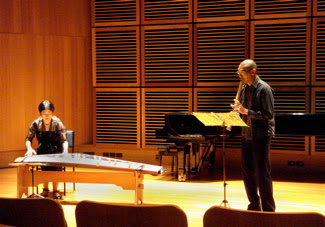
This evening, Kevin [Man] gave his first recital in the Master's Degree on shakuhachi at the Sydney Conservatorium of Music. Kevin is paving the way as the first shakuhachi major at SCM with teacher, Riley Lee. He performed a folksong arrangement for solo shakuhachi, Rokudan, E-mu and San'ya, the latter on his new 2.4 shakuhachi in the reverberant small recital hall underground at Macquarie Street. It was quite sympathetic to shakuhachi. Shoko Ono played koto in the two chamber pieces. [Kevin is best known for his performance in Taikoz and Karak ensembles playing percussion]. Gambatte Kevin!
Monday 4 December 2006
Matsumae International Foundation Research Fellowship
Today, I learned that my application for a Matsumae International Foundation research fellowship was successful. I applied to spend 3 months hosted by Professor Hori at Tokyo University's Artificial intelligence Lab in 2007. The lab is 2 stops from Shibuya on the subway. This will take place over summer (mid-year). Apart from developing my generative responsive environment for gestural interaction research [Hyper-Shaku augmented audio-visual shakuhachi with biologically-inspired models of computational creativity], this opportunity will afford me the chance to pursue shakuhachi lessons with Kakizakai, both in Tokyo and hopefully also visiting Chichibu. I have further developed the research ideas that use camera tracking [computer vision] and computer listening to respond to the chin movement of shakuhachi gestures and intensity and noisiness fluctutations to trigger a group of generative musical and video processes, including the grain characteristics of the granular synthesis engine, thresholds and triggers for a Neural Oscillator Network and video interoplated motion. Progress this far has just been submitted in a conference paper and will contribute to the understand of gestural interaction towards my ARC grant [Gestural Interaction with Aesthetic Information Sonification]. During the fellowship, I hope to integrate IRCAM WiSeBox wireless motion captors as used in Fluid Velocity sensorbike exhibition and cultivate more musical responsiveness, gestural sensitivity and textural variation.
Friday 1 December 2006
Bronwyn’s shak+koto concert
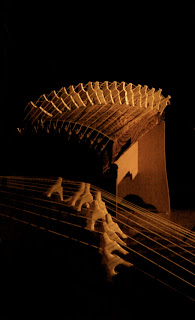
Sound of Japan: An evening of Shakuhachi and Koto
Bronwyn Kirkpatrick + Miyama McQueen-Tokita + Shoko Ono
Friday 1st December 2006, 8.00pm
The Old Darlington School, The University of Sydney
The programme included contemporary compositions: Shikyoku ichi ban (Poeme 1) by Taezo Matsumura (1969); E-mu (Picture Dream) by Hideaki Kuribayashi (1976); Dosei (Voices of the Earth) by Hikaru Sawai (1991); Rin by Hikaru Sawai (2000); Sanka (Song of Praise) by Tadao Sawai (1978); and Futatsu no den-en-shi (Two Pastorals) by Katsutoshi Nagasawa (1973); an arrangement of a traditional silk-pounding song as rhythmical koto duet, Godan Ginuta by Mitsuzaki Kengyo (1853); and the traditional honkyoku shakuhachi solo, Koku.
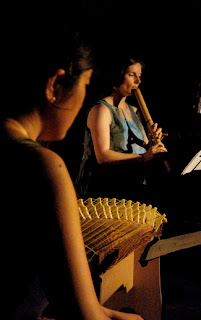

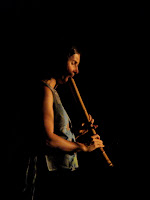
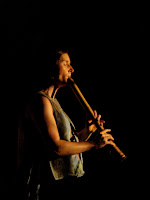



Tuesday 28 November 2006
Shak-blog moved ...
[I have moved the shak-blog from dot-mac to this blogspot due to persistent software glitches using iWeb and tedium of unreliable wysiwyg code editing environments].
Other aspects of travelblog, travel photo-libraries and podcasting remain @ Kirsty Beilharz dot-mac web site (podcasts, travel) but the shakuhachi blog future's here for a while ...
Photos ranging from shakuhachi, shakuhachi camps, geeky, the farm, Japan trip photos, etc. are @ My photos on Flickr
Other aspects of travelblog, travel photo-libraries and podcasting remain @ Kirsty Beilharz dot-mac web site (podcasts, travel) but the shakuhachi blog future's here for a while ...
Photos ranging from shakuhachi, shakuhachi camps, geeky, the farm, Japan trip photos, etc. are @ My photos on Flickr
Friday 24 November 2006
Beautiful Bamboo
 When it comes forth according to intention, or perhaps boldly and mellow with ‘no mind’, my new Miura flute is sounding very beautiful. I have been revising Honshirabe, adapting San’ya [Mountain Valley] and learning Shingetsu, and I have peeked at Koku which has much in common with Shingetsu and San’ya [Mountain Valley]. These are all fairly patient, round, slow pieces that require consideration rather than agility, immense breath control and understanding of the meaning and flow of the music. This might seem obvious to someone who plays Western music but deciphering and discovering further layers of meaning in Honkyoku [Traditional Japanese solo shakuahchi music] can take years, if not a lifetime. I spent four days in the tranquil countryside of my parent’s farm practising. My favourite time is the early morning before the other humans stir and before any domestic sounds commence. Listening for silence reveals how rich the plethora of natural sounds around the lake is: waterfowl, 3 or 4 different kinds of frog, screeching coots, crying lorikeets, black cockatoos, chattering starlings, the reeds in constant motion; occasional cows moo-ing and bulls roaring.
When it comes forth according to intention, or perhaps boldly and mellow with ‘no mind’, my new Miura flute is sounding very beautiful. I have been revising Honshirabe, adapting San’ya [Mountain Valley] and learning Shingetsu, and I have peeked at Koku which has much in common with Shingetsu and San’ya [Mountain Valley]. These are all fairly patient, round, slow pieces that require consideration rather than agility, immense breath control and understanding of the meaning and flow of the music. This might seem obvious to someone who plays Western music but deciphering and discovering further layers of meaning in Honkyoku [Traditional Japanese solo shakuahchi music] can take years, if not a lifetime. I spent four days in the tranquil countryside of my parent’s farm practising. My favourite time is the early morning before the other humans stir and before any domestic sounds commence. Listening for silence reveals how rich the plethora of natural sounds around the lake is: waterfowl, 3 or 4 different kinds of frog, screeching coots, crying lorikeets, black cockatoos, chattering starlings, the reeds in constant motion; occasional cows moo-ing and bulls roaring.Today, after that, the sound of my 2.1 is growing and sounding more comfortable and the physical familiarisation of the finger position and stretch is fading into insignificance.
Inspired by Ben’s shak-web-blog-travel site http://www.benjisan.blogspot.com/ I have included some more photos of the new shakuhachi on flickr: Benjisan's blogspot and Kyorei's Flickr photos
Thursday 16 November 2006
Miura 2.1 shakuhachi




Miura 2.1 shakuhachi Kakizakai had my new 2.1 shakuhachi flute made by Miura Ryuho brought over to Hawaii Shak Festival. Today I started settling into the new finger position and stretch, blowing ro and looking through Shingetsu, which we started learning at Hawaii Shakuhachi Festival under instruction from Furuya Sensei. The instrument is made from a very beautiful, blotched piece of hard bamboo. I am trying hard to be carefully about its humidity in the dry, windy climate we have presently. I also brought back Bronwyn’s 2.4 top joint that had to be repaired after splitting. The 2.4, approximately 2 inches longer than the 1.8 is ‘keyed’ with a fundamental of B rather than D. I am planning to investigate some slower honkyoku pieces on it that benefit from the deep, mellow tone, e.g. Shingetsu, San’ya (3 Valley Yokoyama version), Honshirabe (original piece) and Tamuke [which is intended as a requiem type of piece for ushering in passage from this life to the next). Meanwhile, fast pieces like the agile, fluttery, ostentatious crane piece - Tsuro no Sugomori, high Hifumi Hachigaeshi and intricate San’ya (Mountain Valley) I will continue on 1.8.
Thursday 9 November 2006
Hawaii Shakuhachi Festival
 Hawaii University Music Department 9-12 November, Honolulu. Teachers Riley Lee, Stan Richardson, Chris Blasdel and the three Japanese Masters - Furuya, Matama and Kakizakai. With Megumi-san and Kimura on koto. This involved approximately 10 intensive tuition sessions in groups on select repertoire, private lessons and a students' concert and teachers' concert. Some of the repertoire pieces for this year included: Haru no umi, Rokudan, Murasaki Reiho, Shingetsu, Koden Tsugomori, Tone no funa uta + others ...
Hawaii University Music Department 9-12 November, Honolulu. Teachers Riley Lee, Stan Richardson, Chris Blasdel and the three Japanese Masters - Furuya, Matama and Kakizakai. With Megumi-san and Kimura on koto. This involved approximately 10 intensive tuition sessions in groups on select repertoire, private lessons and a students' concert and teachers' concert. Some of the repertoire pieces for this year included: Haru no umi, Rokudan, Murasaki Reiho, Shingetsu, Koden Tsugomori, Tone no funa uta + others ...Photos at KirstyKomuso's Flickr shakuhachi photos tagged 'Hawaii Shakuhachi Festival '06' [or click on photos above in header]



Saturday 30 September 2006
Country Practice
 A short visit to Oberon, my parent’s farm, to practise. It was freezing at nights [literally] but beautiful when the wind subsided enough not to interfere with the utaguchi [mouthpiece]. Absolute silence from human noises all around, simply frogs, insects buzzing, cows mooing, birds flittering and chattering and my serene cat listening patiently.
A short visit to Oberon, my parent’s farm, to practise. It was freezing at nights [literally] but beautiful when the wind subsided enough not to interfere with the utaguchi [mouthpiece]. Absolute silence from human noises all around, simply frogs, insects buzzing, cows mooing, birds flittering and chattering and my serene cat listening patiently.
Sunday 24 September 2006
Opera House Fusion concert
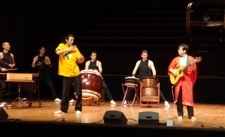 Riley, Taikoz, a street dancer Japanese rap-style, didgeridoo and Japanese guitarists from fusion tonal pop joined forces for a concert marking the year of Australian-Japanese cultural exchange, in the Sydney Opera House. This was also the day so hot with bush-fires - 34 degrees and very dry - that my 1.6 shakuhachi split in two places.
Riley, Taikoz, a street dancer Japanese rap-style, didgeridoo and Japanese guitarists from fusion tonal pop joined forces for a concert marking the year of Australian-Japanese cultural exchange, in the Sydney Opera House. This was also the day so hot with bush-fires - 34 degrees and very dry - that my 1.6 shakuhachi split in two places.
Friday 1 September 2006
Komachi Shak Dinner
 Eighteen people attended dinner and the musical soiree of Bronwyn on shakuhachi and Shoko on koto at Komachi Japanese restaurant in Surry Hills. Six of Ben’s friends including Justien and Robert Henke a.k.a Monolake; Judith, Kevin and his wife, Roy and Emily, Joanne and Kota, Hong Jun, Ning, Lara and Theo, Nathan and I. The food was doused in a generous proliferation of bonito flakes but the music was wonderful, if occasionally overwhelmed by the noisy chatty atmosphere and reverberant space. [the image above is from a previous Komachi dinner when Miyama played koto]
Eighteen people attended dinner and the musical soiree of Bronwyn on shakuhachi and Shoko on koto at Komachi Japanese restaurant in Surry Hills. Six of Ben’s friends including Justien and Robert Henke a.k.a Monolake; Judith, Kevin and his wife, Roy and Emily, Joanne and Kota, Hong Jun, Ning, Lara and Theo, Nathan and I. The food was doused in a generous proliferation of bonito flakes but the music was wonderful, if occasionally overwhelmed by the noisy chatty atmosphere and reverberant space. [the image above is from a previous Komachi dinner when Miyama played koto]
Wednesday 23 August 2006
First Japanese Calligraphy Class
 Today I attended the first of my Japanese calligraphy classes at WEA, 5.30pm Wednesday afternoons. Our teacher is Michiko Honda and I joined after learning of the class from Kevin. She knows Riley Lee and Ben Dixon - what a small world.
Today I attended the first of my Japanese calligraphy classes at WEA, 5.30pm Wednesday afternoons. Our teacher is Michiko Honda and I joined after learning of the class from Kevin. She knows Riley Lee and Ben Dixon - what a small world.It was very interesting to be shown the techniques, both by demonstration of the correct stroke style and order and by Michiko individually guiding our hands and supervising the motion. The onsets and little flick-offs or sweep-away brush motions are extremely critical to the balance and beauty of the characters. Pictured below, for example, is haru, the character for spring, appropriate for the current season commencement. It works around the vertical centre in a symmetrical yet flowing design. The three horizontal beams are of different lengths by design but their thickness, too, can be deliberately and aesthetically un-identical in a non-formatted way, i.e. without rules. For most other details - stroke order, rhythm, beginnings and endings - there is a correct form to learn, practise and follow. The two hour class was actually quite relaxing and enjoyable!
For me, the interesting part is observing through practice, the parallels between calligraphy and shakuhachi playing [that numerous wize sages point out as a connection between shakuhachi, shodo, aikido, chado, sumi-e and other traditional art-forms in Japan]: both take immeasurable time to accomplish the grace and power of the inimmitable masters in the tradition; both have various lineages and styles; extreme composure and patience/awareness to blow/brush timelessly slowly leads to a better feeling; the nuances of tapering off, control, stability of breath or brush-stroke; learning forms; both require mind-body awareness and connection; aesthetics of balance and taste; the Zen quality of utter concentration that excludes external intrusions and mind-chatter achieve envelopment.

Sunday 20 August 2006
Dojo and Ro-buki practising
 Today, my friends Kevin Melville and Bev came over for ro-buki practice. We had not all practised to a level of confidence between times but it was nice to develop a sense of community. We watched some travel slides, drank genmaicha and ate sembae and rice crackers, etc. from Tokyo Mart at Northbridge. I played Hifumi Hachigaeshi - it was good practice to play with an audience, though still never the same as when privately practising! We watched some of the Yokoyama video lesson. I have set up the new furnishings in my lounge room to achieve a hint of Zen simplicity and sincerity: just the simple bamboo mat, Japanese low table and chair to practice on, and the possibility to sit on tatami cushions on the floor.
Today, my friends Kevin Melville and Bev came over for ro-buki practice. We had not all practised to a level of confidence between times but it was nice to develop a sense of community. We watched some travel slides, drank genmaicha and ate sembae and rice crackers, etc. from Tokyo Mart at Northbridge. I played Hifumi Hachigaeshi - it was good practice to play with an audience, though still never the same as when privately practising! We watched some of the Yokoyama video lesson. I have set up the new furnishings in my lounge room to achieve a hint of Zen simplicity and sincerity: just the simple bamboo mat, Japanese low table and chair to practice on, and the possibility to sit on tatami cushions on the floor.
Friday 18 August 2006
Tsugaru Concert Angel Place
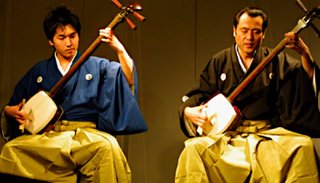 Angel Place - shakuhachi, shamisen and tabla - contemporary multi-cultural fusion concert.
Angel Place - shakuhachi, shamisen and tabla - contemporary multi-cultural fusion concert.The shakuhachi player had very curious double jointed fingers that appeared very tense for playing and an embouchure that enveloped the end of the flute so that Judith thought he was eating it. The primary shamisen player was quite indulgant-looking, rather absorbed and euphoric in his endeavours but his son seemed sincere, accompanied by a serious koto player and amusing tabla player. Plenty of amusement and an easy-listening predominantly modal and pentatonic concert, not at all traditional.
Thursday 17 August 2006
Toru Takemitsu book arrived
 The Music of Toru Takemitsu by Peter Burt arrived from Amazon. In particular, the chapter “into the reflection of an Eastern mirror” considers his approach to November Steps for shakuhachi, biwa and orchestra and Autumn for the same combination a couple of years later. I will be looking at the ways in which Takemitsu tried to integrate Western instruments and an inherent tonality and techniques of orchestration with idiomatic writing for the traditional Japanese instruments. This coincides nicely with the DVD Kaoru Kakizakai sent me of his performance of November Steps performed with NHK Symphony Orchestra.
The Music of Toru Takemitsu by Peter Burt arrived from Amazon. In particular, the chapter “into the reflection of an Eastern mirror” considers his approach to November Steps for shakuhachi, biwa and orchestra and Autumn for the same combination a couple of years later. I will be looking at the ways in which Takemitsu tried to integrate Western instruments and an inherent tonality and techniques of orchestration with idiomatic writing for the traditional Japanese instruments. This coincides nicely with the DVD Kaoru Kakizakai sent me of his performance of November Steps performed with NHK Symphony Orchestra.from Wikipedia:
Tōru Takemitsu (武満 徹 Takemitsu Tōru, October 8, 1930–February 20, 1996) was a Japanese composer of music, who explored the compositional principles of Western classical music and his native Japanese tradition both in isolation and in combination. Born in Tokyo, Takemitsu first became interested in western classical music around the time of World War II. He heard western music on American military radio while recuperating from a long illness. He also listened to jazz from his father's ample collection. Takemitsu was largely self-taught in music. He was greatly influenced by French music, and in particular that of Claude Debussy and Olivier Messiaen. In 1951 he founded the Jikken Kobo, a group which introduced many contemporary western composers to Japanese audiences. Takemitsu at first had little interest in traditional Japanese music, but later incorporated Japanese instruments such as the shakuhachi (a kind of bamboo flute) into the orchestra. November Steps (1967), a work for shakuhachi and biwa (a kind of Japanese lute) solo and orchestra was the first piece to combine instruments from east and west. In an Autumn Garden (1973-79) is written for the kind of orchestra that would have played gagaku (traditional Japanese court music). Works such as Eclipse, (1966) for shakuhachi and biwa, Voyage (1973), for three biwas should also been mentioned as works that are decidedly derived from traditional genres. Takemitsu first came to wide attention when his Requiem for string orchestra (1957) was accidentally heard and praised by Igor Stravinsky in 1959 (some Japanese people wanted Igor Stravinsky to hear some tape recorded music by Japanese composers and put in the wrong side of the tape - when they tried to take it out, Stravinsky didn't let them). Stravinsky went on to champion Takemitsu's work. Takemitsu's works include the orchestral piece A Flock Descends Into the Pentagonal Garden (1977), Riverrun for piano and orchestra (1984, the title is the first word in James Joyce's Finnegans Wake), and the string quartet A way a Lone (1981, another piece inspired by Finnegans Wake). He reworked his 1981 piece Toward the Sea (for flute and guitar) twice, once for flute, harp and string orchestra and later again for flute and harp. Chamber music such as Distance de Fee (1951) for violin and piano, or Between tides, for violin, cello and piano, are to be also mentioned. And such jewels of the piano music as Rain tree sketch (1982), Rain Tree Sketch II (1992), Les Yeux Clos (1979) and Les Yeux Clos II (1988) are considered to be amongst the finest works for the instrument written in the twentieth century. He also composed electronic music and almost a hundred film scores for Japanese films including those for Hiroshi Teshigahara's Woman in the Dunes (1964), Akira Kurosawa's Ran (1985) and Shohei Imamura's Black Rain (1989). His first score was for Toshio Matsumoto's Ginrin. His music for cinema rests deeply upon the concept that a new film needs a new sound colour, and is as much about taking out sounds as about taking them in. Some of the formal concepts in Takemitsu's music depend deeply on visual imagery, taken from paintings, dreams, or his concept (about which he writes much) of the garden. Takemitsu died in Tokyo on February 20, 1996. He was posthumously awarded the fourth Glenn Gould Prize in Autumn, 1996.
Further reading
• Peter Burt, The Music of Toru Takemitsu (Cambridge University Press, 2001)
• Noriko Ohtake, Creative sources for the Music of Toru Takemitsu (Ashgate, 1993)
• Toru Takemitsu, Confronting Silence (Fallen Leaf Press, 1995)
Hifumi Hachigaeshi lesson at Ben’s
 Breath control. Intonation fine. Breath control achieved by constant diaphragm pressure will produce higher register and stability of tone and note decay without fragmentation/splitting sound. Practise leaf-decays in ro-buki and longer breaths. Breathe deeply. Initial ornaments beginning phrases should still be more rapid, make sure tsuri glissandi go high enough audibly. At the climax mura-iki section of part 3, close down throat and inner mouth space [rather than raise tongue] and keep lips very loose to achieve airy rough throaty tone quality like Yokoyama’s. Yokoyama’s ornaments on the the high G are with 2, then 2+3, but 1 can sound OK too if hit the hole accurately and completely cover it to change pitch inflection. Ben and I decided it would be interesting to try ‘Japanese-style’ lessons, i.e. listening in on each other’s for the afternoon and learning from the experience and struggles of one-another. In Japan, Kakizakai’s lesson-teaching filled a whole day and students are free to listen for as long as they can. This is a very efficient way to pick up new knowledge and a little nerve-racking performing with such scrutiny so probably helpful practice.
Breath control. Intonation fine. Breath control achieved by constant diaphragm pressure will produce higher register and stability of tone and note decay without fragmentation/splitting sound. Practise leaf-decays in ro-buki and longer breaths. Breathe deeply. Initial ornaments beginning phrases should still be more rapid, make sure tsuri glissandi go high enough audibly. At the climax mura-iki section of part 3, close down throat and inner mouth space [rather than raise tongue] and keep lips very loose to achieve airy rough throaty tone quality like Yokoyama’s. Yokoyama’s ornaments on the the high G are with 2, then 2+3, but 1 can sound OK too if hit the hole accurately and completely cover it to change pitch inflection. Ben and I decided it would be interesting to try ‘Japanese-style’ lessons, i.e. listening in on each other’s for the afternoon and learning from the experience and struggles of one-another. In Japan, Kakizakai’s lesson-teaching filled a whole day and students are free to listen for as long as they can. This is a very efficient way to pick up new knowledge and a little nerve-racking performing with such scrutiny so probably helpful practice.  
Sunday 13 August 2006
Katsuya Yokoyama videos from Japan
 Mejiro sells VHS taped explanations of main honkyoku in several volumes, each unfolding the techniques and expression behind two pieces. Played by Yokoyama (Living National Treasure & teacher of Kakizakai, Furuya, Riley Lee, etc.). Considering the technology, the tapes sound very good and reach back to an era that we cannot otherwise access. The two I bought include Hifumi Hachigaeshi/Shingetsu and Daha/Yamagoe.
Mejiro sells VHS taped explanations of main honkyoku in several volumes, each unfolding the techniques and expression behind two pieces. Played by Yokoyama (Living National Treasure & teacher of Kakizakai, Furuya, Riley Lee, etc.). Considering the technology, the tapes sound very good and reach back to an era that we cannot otherwise access. The two I bought include Hifumi Hachigaeshi/Shingetsu and Daha/Yamagoe.
Friday 11 August 2006
Monday 7 August 2006
Haruka Kakizakai brought Miura shakuhachi

The exciting arrival of my new shakuhachi made by Ryuho Miura. Kaoru Kakizakai Sensei’s son, Haruka, brought it over to Sydney with him, freshly finished the previous Friday. Haruka is here for a 10-day exchange in Waringah. I commissioned the flute when I was Japan and Miura made it really fast (for him). I am looking forward to practising to harness its big warm sound. Immediately I notice an embouchure adjustment is required and the instrument is fatter and finger-holes more spaced apart so some physical adaptation is required at first. But it also exudes beauty and the care with which it has been crafted in fine details like the exquisitely smooth lacquering inside, the refined utaguchi (mouthpiece cutaway) and lathing of the bamboo root end exposing the raw grain of the pale, natural bamboo colour, free from any staining or smoking. Obviously, this instrument reinforces my intention of a daily and long-term commitment.
Friday 30 June 2006
Shakuhachi blowing Zen hanko
Thursday 22 June 2006
Rockies Shakuhachi Summer Camp
 Photos are now online at dot-mac photo library
Photos are now online at dot-mac photo libraryRockies, Loveland, Colorado - Shakuhachi Summer Camp with Faculty of David Wheeler, Riley Lee, Kaoru Kakizakai, Christopher Yohmei Basdel. 5,000 feet +
After the 10 hour flights from Tokyo, LAX seemed brusque, bustling, smoggy and bombastic, thence 2 hours more to Denver. Bill Fletcher, John-Paul Sicotte and I shared a rental car to Sunrise Ranch, Loveland Colorado. Denver is the 'mile high' city and the ranch sat along a volcanic ridge of mountainous, fertile tract on the verge of desert, a further two hours from Denver and 500m higher. Much of the journey from LA to Denver flew over desert, picturesque canyons, gorges, meandering rivers in windy rounded snakes and finally the still snow-capped (in summer) Rockies mountain plateau. Arriving the night before camp commencement, we ate the first of a series of organic, home-grown (in the ranch), predominantly vegetarian and vegan meals including many unrecognisable but fresh local herbal garden ingredients, weird mints, types of spinach, purple and yellow tomatoes, many lentils, indigenous eggs, tofu served by the cheery hosts - Divine Emissaries of Light, one of the oldest, self-sufficient spiritual communes in the USA (happy hippies) who own and maintain the ranch, a conference and retreat centre.
At night, the wild canine cries of a pack of coyotes could be heard reverberating through the hills. We sighted elk in the adjacent cattle paddock, tall and proud like giant deer with magnificent antlers and a fawn. Amongst the other local wildlife, we were warned to be vigilant for pervasive rattle snakes such as the one spotted by Cory Sperry who purportedly leapt very far and we had to wash out recycling carefully to not exacerbate the bear problem that recently saw a bear and her cub foraging close to the dormitories. By night in the rain, frogs emerged eating beetles attracted by the lights.
Our Faculty comprised Christopher Yohmei Blasdel, Riley Lee, Kakizakai Sensei, David Wheeler and Yoko Hiraoka (koto). The program involved a student concert (in which Doug and I played Honte Choshi as a duet), wonderful professional concert by the staff and a sight-reading ensemble/duet night. Three sessions each day were on selected repertoire intensively, ranging from traditional solo honyoku pieces, sankyoku vocal and shakuhachi with koto or shamisen pieces and modern ensemble and solo pieces. Early morning breathing/spirituality and shakuhachi classes started at 6.30am while others like Riley, David Wheeler and Doug, etc. went for an early morning high altitude run and Kakizakai stood outside playing Yamagoe which drifted beautifully and far. Kurita-san 'father' of my shakuhachi, set up in residence repairing instruments with its lacquer concocted from poison ivy. Christopher Blasdel performed aikido demonstrations with Lee. Morning theory talks included Riley on different forms of breathing torture, both hyper and hypo-ventilation to build mind control over matter and possible some deep breathing and diaphragm muscles, too. Chris talked on mind/body awareness, balance and control, Kakizakai on dragon breath subtle onsets and tapered note decays, robuki and embouchure and David Wheeler presented chamber music and particularly unfolded the koto instrument (like a horizontal harp from Japanese boxwood with ivory bridges and plectra. But the shamisen wins the anti-ecology award with a belly made from stretched cat-skin and to balance things, the rear is made from dog, with a tortoise-shell bridge, ivory plectrum and some other protected species - was it buffalo bits?
It was a great opportunity to make friends with like-minded enthusiastic eccentrics: a family of black sheep, ranging from musicologists, musicians of other instrumental backgrounds, MDs, scientists, beginners, people who had been playing 30-50 (Kurita) years and from locations as diverse as Texas, Edmonton Canada, East and West USA, Hawaii, Japan and Australia.
The successions are Shak and Surf in Hawaii and Sydney 2008 hosting the World Shakuhachi Festival for which I will help Christopher Blasdel organise the academic conference, perhaps with Allan Marett, to be discussed in Tokyo next week.
Friday 16 June 2006
Japan trip for lessons with Kakizakai
 Lessons in Chichibu and Tokyo. 16 June - 10 July with break in the middle for Shak Camp, USA. You can read detail about this under my dot-mac travel blog
Lessons in Chichibu and Tokyo. 16 June - 10 July with break in the middle for Shak Camp, USA. You can read detail about this under my dot-mac travel blog
Wednesday 31 May 2006
Hyper-Shaku book chapter in progress
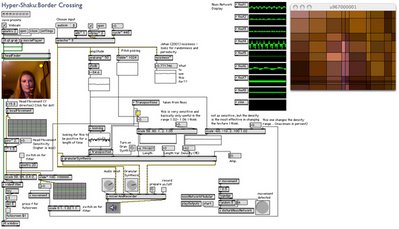 Explaining the generative a-Life, biologically inspired and Granular Synthesis processes configured by gestural interaction captured using web-cam [computer vision] and audio input [looming, loudness, roughness/noisiness] with Sam. Sam helped program the transformations of Neural Oscillator Network (NOSC) and GS grain density, size and distribution transformed by breathiness in the auditory analysis.
Explaining the generative a-Life, biologically inspired and Granular Synthesis processes configured by gestural interaction captured using web-cam [computer vision] and audio input [looming, loudness, roughness/noisiness] with Sam. Sam helped program the transformations of Neural Oscillator Network (NOSC) and GS grain density, size and distribution transformed by breathiness in the auditory analysis.Modular Hyper Instrument Design using Biologically Inspired Generative Computation for Real Time Gestural Interaction
Contemporary computing enables calculation of complex generative algorithmic processes in real time. This facilitates the integration of biologically inspired generation into interactive interfaces requiring immediate and creative responses. Hyper instrument design is the augmentation of acoustic instrument performance. This chapter describes a model for enhancing traditional instrumental performance with responsive digital audio and visual display using artificial biological systems to generate the new artistic material meshed with the musical expression. The generative process is triggered and moderated by the gestural interaction of the human performer (sensed by motion captors, computer vision and computer hearing). The model is a scalable and modular system in which different generative processes can be interchanged to explore the effect of their interaction with each other and responsiveness to the performer. The modular approach allows customized interaction design at the sensing, generative computation and display stages for real time musical instrument augmentation. The purpose behind modular interaction engine construction is to allow customization for different performance scenarios and to produce a proliferation of design possibilities from a scalable and re-usable set of computation processes in Max/MSP + Jitter (graphical real time programming environment). Interchangeable sensing technologies and adjustable, iterative generative processes are amongst the parameters of individualization. This chapter describes the performance, mapping, transformation and representation phases of the model. These phases are articulated in an example composition, HyperShaku (Border-Crossing), an audio-visually augmented shakuhachi performance environment. The shakuhachi is a Japanese traditional end-blown bamboo Zen flute. Its 5 holes and simple construction require subtle and complex gestural movements to produce its diverse range of pitches, vibrato and pitch inflections, making it an ideal candidate for gesture capture. The environment uses computer vision, gesture sensors and computer listening to process and generate electronic music and visualization in real time response to the live performer. The integration of Looming and Neural Network Oscillator (NOSC) generative modules are implemented in this example.
Listen to example and watch video
Saturday 20 May 2006
Sawai Sydney Koto School concert
Friday 7 April 2006
UWS Observatory Concert
Wednesday 29 March 2006
First lesson with Riley Lee
Sunday 12 February 2006
Australian Shakuhachi Festival
 Australian Shakuhachi Festival Canberra at ANU 10-13 February, 2006. The start of my shakuhachi learning experience. Teachers included Bronwyn Kirkpatrick, Riley Lee, Matama, Furuya, Kakizakai, Andrew MacGregor (Melb), Stuart Ransom (Qld) ... 3 main days of lessons, group classes, in my case the absolute beginners just making a noise, learning basic first octave fingering and concepts of meri and kari head position pitch shifting.
Australian Shakuhachi Festival Canberra at ANU 10-13 February, 2006. The start of my shakuhachi learning experience. Teachers included Bronwyn Kirkpatrick, Riley Lee, Matama, Furuya, Kakizakai, Andrew MacGregor (Melb), Stuart Ransom (Qld) ... 3 main days of lessons, group classes, in my case the absolute beginners just making a noise, learning basic first octave fingering and concepts of meri and kari head position pitch shifting.
Bought Kurita 1.8
Subscribe to:
Posts (Atom)





